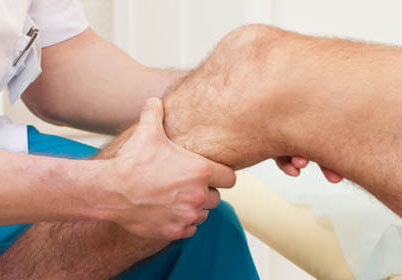Manual Therapy in Jacksonville, FL
Manual physical therapy is a specialized modality to treat your joints and soft tissues directly by hand instead of using a device or machine. Manual therapy can improve the mobility and function of your soft tissues so you can return to moving efficiently and pain-free.
According to the American Physical Therapy Association, manual therapy uses skilled hand placements to deliver joint and soft tissue movement intended to:
- Improve tissue extensibility
- Increase range of motion
- Promote relaxation
- Mobilize or manipulate soft tissue and joints
- Modulate pain
- Reduce soft tissue swelling and inflammation
Manual Therapy vs. Massage Therapy

Manual therapy differs from massage therapy in several ways. Massage therapy reduces tension, stress, and anxiety for overall wellness and improved circulation.
Manual therapy, on the other hand, treats a specific part of your body to improve the overall body system so you can move well and without pain. It requires skill and intention toward achieving a functional goal.
To achieve those goals, one of our physical therapists will provide hands-on treatment that will:
- Move your joints in specific directions and at different speeds to regain movement.
- Stretch your muscles to improve ease of movement.
- Provide passive movements of your affected body part to increase range of motion.
- Require you to move your body part against the therapist’s resistance to improve muscle activation and timing.
Manual therapy can treat functional limitations such as:
- Loss of joint strength
- Loss of joint mobility
- Loss of range of motion
Manual Therapy Techniques
Specific techniques utilized by one of our physical therapists are determined based on your musculoskeletal examination.
Manual therapy techniques include:
- Manual traction
- Joint mobilization
- Joint manipulation
- Myofascial release
- Manual lymphatic drainage
- Trigger point therapy
A Smart Body physical therapist will determine how, when, and what direction and speed of manipulation and mobilization your joints need to help you reach maximum results.
Joints can also be moved through the careful movement of your limbs and achieved through:
- Passive Range of Motion, PROM
- Active Assistive Range of Motion, AAROM
- Active Range of Motion, AROM
What conditions does manual therapy treat?
Manual therapy is utilized for optimal recovery from various musculoskeletal and pain conditions, including but not limited to:
- Headaches: tension headaches, migraines
- TMJ DysfunctionNeck Pain: disc pathology, muscle spasm, post-surgical neck pain
- Shoulder Pain: impingement syndrome, scapular dyskinesia, frozen shoulder or adhesive capsulitis, post-surgical shoulder
- Thoracic Spine or Mid-back Pain: rib hypomobility, rib hypermobility, scoliosis
- Low Back Pain: disc pathology, facet joint impingement, facet joint hypomobility, spinal stenosis, post-surgical back pain
- Hip Pain: hip impingement, sciatica, hip bursitis, post-surgical hip pain, hip replacements
- Knee Pain: patellofemoral dysfunction, IT band tendonitis, post-surgical knee pain, knee replacements
- Ankle Pain: ankle sprains, chronic ankle pain, ankle arthritis, post-surgical ankle pain
- Fibromyalgia
Pelvic Floor Manual Therapy
Muscles and other soft connective tissues make up your pelvic floor, and they all can benefit from manual therapy. These muscles can also get tight or weak, leading to pain and dysfunction. And if your pelvic floor prevents you from living the life you expect, then an evaluation by one of our physical therapists can help.
Since your pelvic floor has specific functions, individually tailored treatment plans will determine which manual technique is utilized.
Pelvic floor manual therapy can treat:
- Incontinence (urinary and/or fecal)
- Bowel Constipation
- Pelvic Pain
- Vaginismus
- Erectile dysfunction
- Dyspareunia (painful intercourse)
- Pelvic Organ Prolapse
After completing a medical history form, your physical therapist will interview you and perform an orthopedic examination based on your current complaints. Examinations take place in private rooms. External and internal physical examination of your pelvic floor will give your therapist a complete picture of what is causing your issues. Your physical therapist will discuss the benefits and disadvantages of each method and will always ask for your consent first.
During a pelvic floor external examination, your physical therapist will:
- Palpate the outside of your pelvic floor with gloved hands.
- Assess all the soft tissues and muscles that surround and attach to your pelvis.
- Check for pain, tenderness, or tightness along the pelvic floor.
Pelvic Floor Therapy At Home
Based on your assessment, your physical therapist will recommend specific treatment time, duration, and frequency of visits and assign you a home exercise program. Each visit should help you achieve functional pelvic health goals.
As soon as you feel confident and competent, your physical therapist will teach you how to complete an advanced home exercise program and self-massage at home.
Your physical therapist can also teach you how to set up and perform self-massage or use vaginal dilators to help you relax or stretch your pelvic floor tissues. Using these tools not as intended can worsen pelvic floor dysfunction, so use them as instructed!
Why Choose Smart Body Physical Therapy for Manual Therapy
While all physical therapists can use manual therapy in their practices, some spend more time and resources to become proficient in this practice area. Our physical therapists specialize in manual therapy, and can mobilize and manipulate joints and limbs to decrease pain, increase range of motion, or reduce inflammation in joint dysfunction.
At Smart Body Physical Therapy, we understand the importance of using manual therapy techniques as one of many tools used to help our patients reach their goals.
